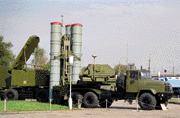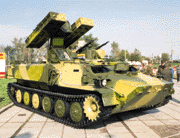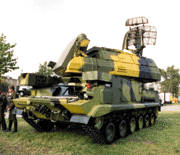The 1999 air campaign over Kosovo
presents lessons about the current state of the surface-to-air-missile
(SAM) threat that may be seriously misunderstood. Since
aircraft losses were so few, complacency about the SAM
threat may be an unwarranted conclusion. The air campaign
was waged against a relatively modest air-defense system
with no new-generation radar-guided missiles. Yet the
presence of small numbers of advanced infrared (IR)-guided
SAMs forced NATO air planners to restrict fixed-wing air
operations to altitudes over 10,000 ft., thus inhibiting
attacks and contributing to collateral damage to civilian
targets. One overlooked aspect of the air campaign was
the high loss rate suffered by NATO unmanned aerial vehicles
(UAVs) and its implications for “information warfare.”
POST-COLD-WAR PROLIFERATION
 |
| Sales of high-end Russian SAMs,
like the Almaz S-300PMU-1 (SA-10) seen here, have
been very slow, with confirmed sales in recent years
limited to China and Greece. (photo by S. Zaloga) |
The deployment of advanced SAMs
over the past decade has been slowed due to the collapse
of the Soviet Union. The Soviet Union had been the world’s
largest exporter of SAMs, especially medium- and high-altitude
systems. Many of these weapons were delivered to Third
World countries on soft credit or without charge, motivated
by Soviet foreign-policy considerations. This policy has
ended, and high-tech arms transfers to the developing
world have shrunk dramatically. In recent years, Russian
arms export has been driven by the need to earn hard currency
in the hopes of arresting the catastrophic decline in
the economic fortunes of Russian defense industries. Sales
of advanced SAMs have been further hindered by arms embargoes
against several major Soviet export clients, such as Iraq
and Libya, and by lingering debts to the former Soviet
Union by other clients such as Syria. As a result, there
have been only a handful of sales of the “double-digit”
SAMs in recent years, hardly any to the “countries of
concern.” China has acquired modest numbers of the Antey
Tor-M1 (SA-15) and Almaz
S-300PMU (SA-10). Greece
has purchased the Antey Tor-M1 and, responding to international
pressures, deployed the controversial S-300PMU on Crete
instead of Cyprus. India has acquired small numbers of
the Tunguska air-defense
gun vehicle with its integral Treugolnik (SA-19) missile
and has reportedly signed deals for the Almaz S-300PMU
(SA-10) and Antey S-300V
(SA-12). Finland acquired a small number of Buk-M1
(SA-11) mobile SAMs in a deal to erase old Soviet-era
debt. While the Soviet Union had SAM export sales on the
order of 5,000 missiles annually in the mid-1980s, recent
sales have fallen tenfold to barely 500 annually. Furthermore,
most of these have been inexpensive manportable SAMs,
not the sophisticated medium- and high-altitude systems.
This pattern has not been confined to Russia, though Russia
represents the most dramatic case. Non-Soviet SAM export
sales averaged about 5,000 a year in the mid-1980s, and
now are down to about 2,000 annually. As in the Russian
case, most of these are manportable SAMs, with the French
Mistral alone accounting for about 65 percent of the non-
Soviet sales.
AIR DEFENSES IN OPERATION ALLIED
FORCE
 |
| Serbia's strategic air defense
was based around the older S-125 Pechora (SA-3) system.
Although old, upgrades and clever tactics enabled
it to down a F-117 stealth aircraft. (photos by S.
Zaloga) |
The Serbian air defenses in the
Kosovo air campaign represented a fairly typical pattern
of Soviet air defenses from the 1960-70 period. They are
representative of the effects of stagnation in modern
SAM proliferation through much of the world that had been
dependent on Soviet supplies. As a result, they have implications
beyond the Kosovo campaign.
Serbia’s strategic air defense
was handled by a dwindling number of vintage Almaz S-75
(SA-2) and a small number of partly modernized Almaz
S-125 Pechora (SA-3). Prior
to the Yugoslav civil war, the air-defense command had
six batteries of S-75s, totaling about 40 single-rail
launchers, of which only three batteries were still operational
in 1999. There were also 14 batteries of S-125s with 60
4-rail launchers — of which about 50 launchers were still
operational in 1999.
Air defense of the field army
was handled by four regiments of 2K12
Kvadrat (SA-6) mobile radar-directed SAMs, with two
of the regiments stationed with the Serbian forces in
or near the Kosovo area. Yugoslavia originally had about
70 of these, but high attrition during the civil war left
only about 25 in the field in 1999. Furthermore, these
launcher vehicles really constituted only 6 autonomous
batteries since a 1S91 (Straight Flush) radar vehicle
is needed provide guidance for every four missile-launch
vehicles. This cumbersome arrangement restricted the flexibility
of the Kvadrat batteries.
Air defense at divisional level
included Strela-1 (SA-9)
and Strela-10 (SA-13)
IR-guided, low altitude, vehicle-mounted SAMs. The
more common of these was the older 9K31 Strela-1 (SA-9),
with some 113 launcher vehicles delivered to Yugoslavia
in the 1970s. The associated missile was manufactured
in Yugoslavia under license before the war. The Strela-1
system consists of four missile launchers, mounted on
a wheeled BRDM-2 light armored vehicle, and has an effective
ceiling of 3,500 m. It employs an older uncooled lead-sulphide
seeker with no IR counter-countermeasures capabilities.
Yugoslavia received a total of only 17 of the more modern
9K35M Strela-10 (SA-13) in the 1980s. This is an evolutionary
descendent of the Strela-1, but mounted on a tracked MT-LB
chassis. The Strela-10 has IR counter-countermeasures
with later versions of the missile having a two-channel
seeker. Besides these standard systems, Serbian air-force
units attempted to create improvised air-defense missiles
for their bases using IR guided air-to-air missiles. The
normal aircraft rail-launchers for R-60 (AA-8 Aphid) and
R-73 (AA-11 Archer) were lashed on to ground mountings
codenamed Pracka (Slingshot). Serbian sources later claimed
that the R-73 launcher was successful, though there is
little evidence to support this.
Small-unit air defense was handled
by anti-aircraft guns and a significant number of old
Strela-2M (SA-7) and
new Igla (SA-16/-18) manportable
SAMs. The Strela-2M was produced in Yugoslavia under the
name Strela-2M2J Sava and was available in large numbers.
Serbia managed to purchase about 75 of the new 9K310 Igla-1
(SA-16) manportable IR-guided SAM from Kazakhstan and
other sources in the mid-1990s. In total, there were about
850 manportable IR-guided SAMs in the Serbian armed forces
in 1999.
NATO took the threat posed by
IR-guided SAMs the most seriously, as these had been the
primary source of casualties in Operation Desert Storm.
There was some confidence that the radar-directed missiles
could be dealt with using traditional means of suppression
of enemy air defenses (SEAD) and electronic countermeasures
(ECM). Unlike radar-guided SAMs, IR-guided SAMs present
a serious suppression problem since the launchers rely
entirely on passive sensors and are generally smaller,
more mobile and easier to conceal. The older-generation
IR-guided SAMs, such as the Strela-2M (SA-7) and Strela-1
(SA-9), use seekers that are more susceptible to conventional
ECM, such as flares and “hot brick” IRCM. The newer IR-guided
systems, such as the manportable Igla (SA-16/-18) and
vehicle-mounted Strela-10 (SA-13), have more robust counter-countermeasures.
Rather than risk aircrews to these systems, NATO planners
restricted most air operations above 10,000 ft., where
these small SAMs have very low probabilities of kill due
to kinetic and sensor limits. Furthermore, the presence
of these SAMs raised concerns about operating attack helicopters
such as the AH-64 Apache deep behind Serbian lines and
was a significant factor in US reluctance to deploy the
Apache in combat.
The altitude limits succeeded
in minimizing casualties to IR-guided SAMs. A single aircraft
was hit by a shoulder-fired SAM, but it failed to fuze
and bounced off the aircraft. Several other aircraft were
damaged, possibly by this type of weapon. The mere presence
of these weapons, however, inhibited air operations to
a significant extent. Due to weather conditions, it forced
NATO to abandon air missions when cloud cover precluded
operations below the altitude limit, and none of the air
forces other than the US had munitions such as the Joint
Direct Attack Muntition (JDAM) that could be used in all-weather
conditions. Secondly, it contributed to collateral damage
against civilian targets. Although NATO aircraft did have
electro- optical sensors for surveying targets before
the strike, when used from medium altitudes, the resolution
of the image in the cockpit is often mediocre. Civilian
tractors and buses can be mistaken for military vehicles.
LESSONS LEARNED
 |
Although there were few in
service in Kosovo, the Strela-10 (SA-13) was one of
the more effective Serbian air-defense systems, since
its guidance system includes IR counter-countermeasures.
(photos by S. Zaloga) |
The lesson from this campaign
for armies likely to face NATO or US air power is that
investment in relatively inexpensive, new-generation IR-guided
SAMs is the most cost-effective solution for tactical
air defense. Even if they cause few or no aircraft casualties,
they so inhibit air operations at lower altitudes that
they can at least partly contribute to the air defense
of ground units and degrade the effectiveness of attacking
air units. This lesson has not been lost on several countries,
and there is some evidence that both Iraqi and North Korean
observers were present in Serbia during the air campaign.
The lesson for NATO and US air
planners is that the threat posed by IR-guided missiles
needs to be addressed more seriously. The development
and deployment of directed IR countermeasures (IRCM) has
been slow in the US Air Force and Navy, and even slower
in the European NATO air forces. While the advent of GPS-guided
munitions, such as the JDAM and the Joint Stand-Off Weapon
(JSOW), will provide the ability to launch strikes against
targets in all weather from safe altitudes, it does not
solve the problem of recognition of mobile targets from
these altitudes. Until the resolution of typical imaging-IR
targeting sensors improves considerably, there will be
some need to approach the mobile targets closely enough
to determine visually whether they are hostile or civilian.
Existing NATO electronic countermeasures
were largely effective against the Serbian radar-directed
SAMs. A total of about 700 Kub (SA-6) and S-125 Pechora
(SA-3) missiles were fired, with only two aircraft being
downed. The fact that one of the two downed aircraft was
an F-117 stealth aircraft has obscured the fact that Serbian
medium- and high-altitude air defenses were almost totally
ineffective — even after having expended about 80 percent
of their inventory of missiles. Traditional SEAD tactics
were especially effective against the semi-fixed S-125
Pechora (SA-3), as its massive RSN-125 (Low Blow) engagement
radar proved vulnerable. NATO claimed to have knocked
out at 11 of 14 operational radars. Like many older systems,
several launchers depended on a single engagement radar,
so when the radar was knocked out, several launchers were
rendered useless. The tracked, mobile 1S91 (Straight Flush)
used with the Kvadrat (SA-6) system proved far more difficult
to target, and it is not clear if any were knocked out.
These systems were difficult for the Serbs to operate,
since each battery of four 2P25 launcher vehicles depended
on a single 1S91 radar vehicle for missile guidance and
were cumbersome to deploy. As a result, they tended to
be used for strategic air defense, moving when necessary
to avoid NATO air attacks.
 |
| Systems like the Antey Tor-M1
(SA-15) may become benchmarks of the future threat
and, unlike the old Kvadrat (SA-6) used by the Serbs,
is entirely autonomous with its own onboard engagement
radar. The Tor has already been sold to China and
Greece. (photo by S. Zaloga) |
The effectiveness of the Serbian
air-defense network was also undermined by the age of
the systems and by spotty maintenance. Soviet air-defense
missiles typically had a warrantied shelf life of seven
years, and most — if not all — of the Serbian S-125 (SA-3)
and Kvadrat (SA-6) missiles were time expired. Time-expired
missiles can often be brought back to “zero-time” at overhaul
facilities. Serbian facilities, however, had suffered
from the disruption of the Yugoslav dissolution, and rebuild
at Russian facilities was unlikely due to international
sanctions. Time-expired missiles may still be functional
long after their warranty date, and there are known cases
of successful launches of missiles more than ten years
after warranty expiration. Nevertheless, the age of the
missiles degraded the overall effectiveness of the air-
defense system and may have contributed to the low success
rate of the medium- and high-altitude SAMs. This pattern
is likely to be repeated in many other armed forces, as
the Soviet network of repair and upgrade programs for
older missile systems has largely collapsed.
In 1998, prior to the Kosovo air
campaign, the Serbian arms export company Yugoimport-SDPR
advertised a new upgrade package for the S-125 Pechora
(SA-3) and Kvadrat (SA-6) missiles systems. This was widely
ignored in the West. The upgrade included the addition
of a thermal-imaging camera and laser rangefinder to the
S-125 fire-control system to allow the missile to be launched
without first acquiring the target using the usual RSN-125
(Low Blow) radar. Data can be fed to the system from other
radars. As a result, traditional means of defense against
this system were undermined since they rely on radar warning
and traditional guidance sequences. The loss of the F-117
stealth strike aircraft has been attributed to this upgrade,
combined with clever detection tactics and stereotyped
NATO flight planning (see “Shrewd Tactics May Have Downed
Stealth Fighter,” JED, June 1999). The Serbians apparently
networked their air-defense radars and were able to provide
altitude and location information to the Pechora battery
to ambush the F-117 when it flew along a predictable flight
path. The loss of the F-117 appears to have far more to
do with complacency and poor tactics than with technology.
The Pechora upgrade helps to extend the life of this very
old system, but it is not particularly robust and could
be overcome both by tactics and technology.
The loss of the F-117 is a reminder
that even forty-year-old systems can still have bite left
in them, especially after modernization. The Russian air-defense
firm Almaz is offering a similar upgrade package for both
the S-75 Volga (SA-2) and S-125 Pechora (SA-3). Many countries
unable to afford the new Almaz S-300PMU (SA-10) will,
at least, be tempted to extend the life of their old systems.
Egypt has become the launch customer for the Pechora upgrade,
signing a contract to rebuild fifty systems in March 1999.
One of the overlooked lessons
of the Kosovo air campaign was the extremely high attrition
rate of NATO reconnaissance UAVs. Some 25 to 27 were lost
in operations, of which 16 were US air vehicles. Some
of these were lost to accidents, but a significant number
were downed by IR-guided SAMs, according to Serbian sources.
Many fell victim to the Strela-1 (SA-9) and Strela-10
(SA-13) vehicle-mounted SAMs, which have a higher-altitude
capability than the manportable systems. There has been
much talk about the information revolution in modern warfare.
Yet something has to go out and collect this information,
and high-resolution optical images are available only
from airborne platforms when weather conditions are cloudy.
Thus, UAVs played a vital role in intelligence collection
and targeting during the campaign. The loss of unmanned
UAVs is certainly preferable to the loss of manned reconnaissance
aircraft in politically charged operations such as Kosovo.
However, it remains to be seen whether these high attrition
levels would be sustainable in a larger war against a
better-equipped enemy. Most of the tactical UAVs have
too small a payload to carry any reasonable ECM or IRCM
package, so other approaches such as signature reduction
may be necessary.
BEYOND KOSOVO
The most important lesson from
Kosovo should not be that the radar-directed SAM threat
can comfortably be ignored. Even though radar-directed
SAMs did not present much of a threat in Kosovo, the hiatus
in the sale of modern radar-guided SAMs may be coming
to an end. The embargo has been lifted against Libya,
and Russia is discussing advanced-SAM sales with Syria
and other countries. France and Russia are pushing to
lift the embargo against Iraq, and when this happens,
a major SAM sale is likely to be one of the first aspects
of Iraqi military modernization. Proliferation of advanced
radar-directed SAMs may be accelerated by licensed production
of Russian systems such as the Tor or S-300PMU in China.
The Kosovo air campaign would have been a far more painful
experience for NATO had there been even a single battery
of S-300PMU in operation. There have never been any air
operations carried out against an opponent defended with
a missile system using contemporary track-via-missile
guidance.
Nor is the technology remaining
static. Many missile firms are beginning to realize that
few countries can afford to replace the large and expensive
high-altitude SAMs like the Russian S-125
(SA-3) or the US MIM-23
HAWK. Instead, there is considerable work being done
on multistage hyper-velocity missiles, which attempt to
provide a range envelope similar to the HAWK, but with
for a lower purchase price and operating costs more similar
to older medium-altitude systems. These include western
systems like the Bofors RBS.23 BAMSE and Russian systems
like Pantsir and Sosna. The Kosovo air campaign continued
to demonstrate the difficulty of dealing with small, mobile
SAM systems. The new systems will be more difficult to
target, since each launch vehicle contains its own engagement
radar and, thus, can operate autonomously, unlike the
cumbersome Kvadrat and Pechora systems used by the Serbs.
A proliferation of new SAMs of this type will complicate
the SAM threat in future conflicts.
Steven J. Zaloga is a senior
analyst at Teal Group Corp. responsible for its publication
“World Missile Briefing.” He is the author of numerous
books and articles on missiles and military technology,
including the 1989 book Soviet Air Defense Missiles.
Èñòî÷íèê èíôîðìàöèè